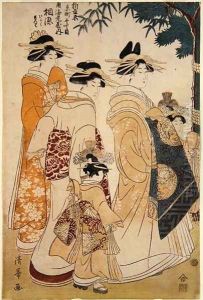Torii (Torii Kiyomitsu II) Kiyomine Paintings
Torii Kiyomine, also known as Torii Kiyomitsu II, was a Japanese ukiyo-e artist of the Torii school, which was known for its close association with the kabuki theatre. Born in 1786 in Edo (present-day Tokyo), Kiyomine was the grandson of the prominent ukiyo-e master Torii Kiyomitsu, who had made significant contributions to the Torii school's style, particularly in the realm of actor prints and theater posters.
Kiyomine's father, Torii Kiyonaga, was also a distinguished artist of the time, noted for his elegant portrayals of beautiful women (bijinga) and for a style that marked the peak of the Torii school's aesthetic. Under the tutelage of his father, Kiyomine honed his skills and initially continued the traditional focus of the Torii school, emphasizing prints related to the kabuki theater.
During his career, Kiyomine witnessed a shift in the ukiyo-e genre, as the late 18th and early 19th centuries saw changes in artistic tastes and the introduction of Western art techniques. Kiyomine himself began to experiment with these new styles, incorporating elements such as Western perspective and shading into his work. Despite this, he remained deeply connected to the theatrical world, and many of his prints reflect this enduring relationship.
Kiyomine's works are characterized by their vivid coloration and dynamic portrayal of kabuki actors. However, his output was not limited to actor prints; he also produced landscapes, portraits of courtesans, and illustrations for books, demonstrating a versatility that allowed him to adapt to the evolving art market of his time.
The latter part of Kiyomine's career saw the Torii school's decline in prominence as newer styles and schools of ukiyo-e, like the Utagawa school, gained popularity. Despite this, Kiyomine continued to work until his death in 1868, leaving behind a body of work that not only reflects the traditional Torii style but also illustrates his personal adaptation to the artistic transitions of the period.
Today, Kiyomine's prints are appreciated for their historical value and their role in showcasing the evolution of ukiyo-e and kabuki-related art during a time of significant cultural and artistic transformation in Japan.
